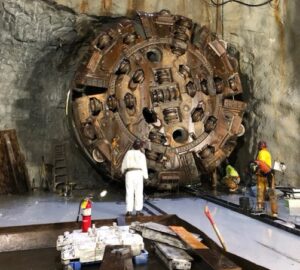
Over a century ago, Indianapolis built its first sewer system. Because there was no indoor plumbing at the time, the sewer system only transported stormwater (rainfall, snow, snow-melt, ice-melt, and the associated run-off) away from streets, homes and businesses.
When indoor plumbing came along, so did a new “state-of-the-art” idea: combing stormwater and raw sewage in the same system. As the population of the city grew and the amount of sewage in the system increased, heavy rains would cause the system to fill up and raw sewage overflowed into portions of the White River, Fall Creek, Eagle Creek, and more. Waterways became polluted and the potential for sewage backing up into homes and businesses became a threat to human health.
Many cities in the country face these yet today and are required by the U.S. Environmental Protection Agency (EPA) Clean Water Act to develop plans to reduce these overflows to protect human health and the environment.
In Indianapolis, Citizens Energy Group must complete a $2 billion Long Term Control Plan by 2025 to address these combined sewer overflow events. The plan is under a consent decree with the EPA and the Indiana Department of Environmental Management (IDEM).
Known as DigIndy, this tunnel system will store more than 250 million gallons of sewage over 200 feet below the ground during and after wet weather events. The sewage will slowly be released to the Southport Advanced Wastewater Treatment Plant, keeping it out of our waterways and almost eliminating overflow events.
As the project nears completion, some have been left to wonder if the planned capacity is enough to cope with increased rainfall the city has experienced in recent years. Chicago has faced similar questions and has implemented green infrastructure projects to reduce stormwater going into the system in the first place.
City governments and homeowners alike can play a role in reducing stormwater by installing rain barrels, planting trees to catch water, using pervious pavers on roads and parking lots or building in “green requirements” to zoning ordinances. And of course we can continue to keep lawn chemicals and household polluntants out of the stormwater runoff too!
To learn more about DigIndy visit: https://www.citizensenergygroup.com/Our-Company/Our-Projects/Dig-Indy
